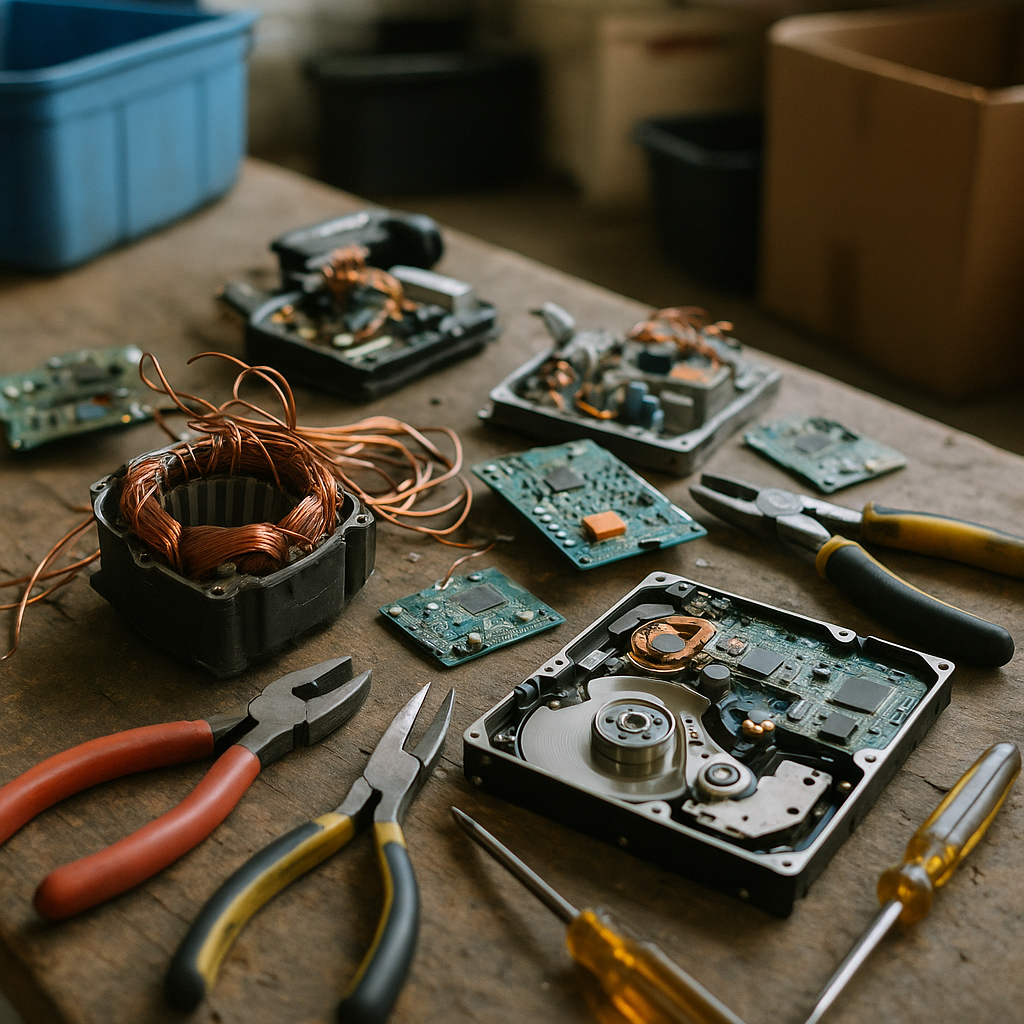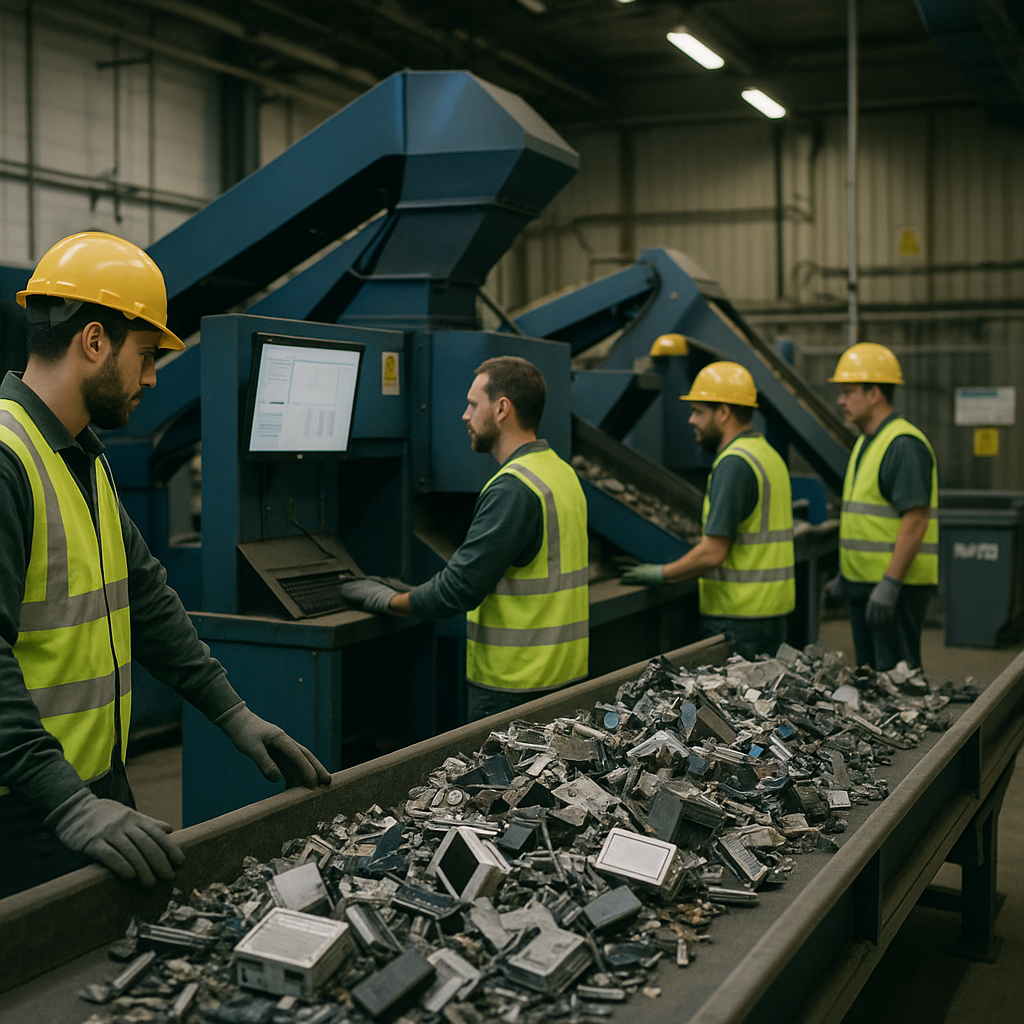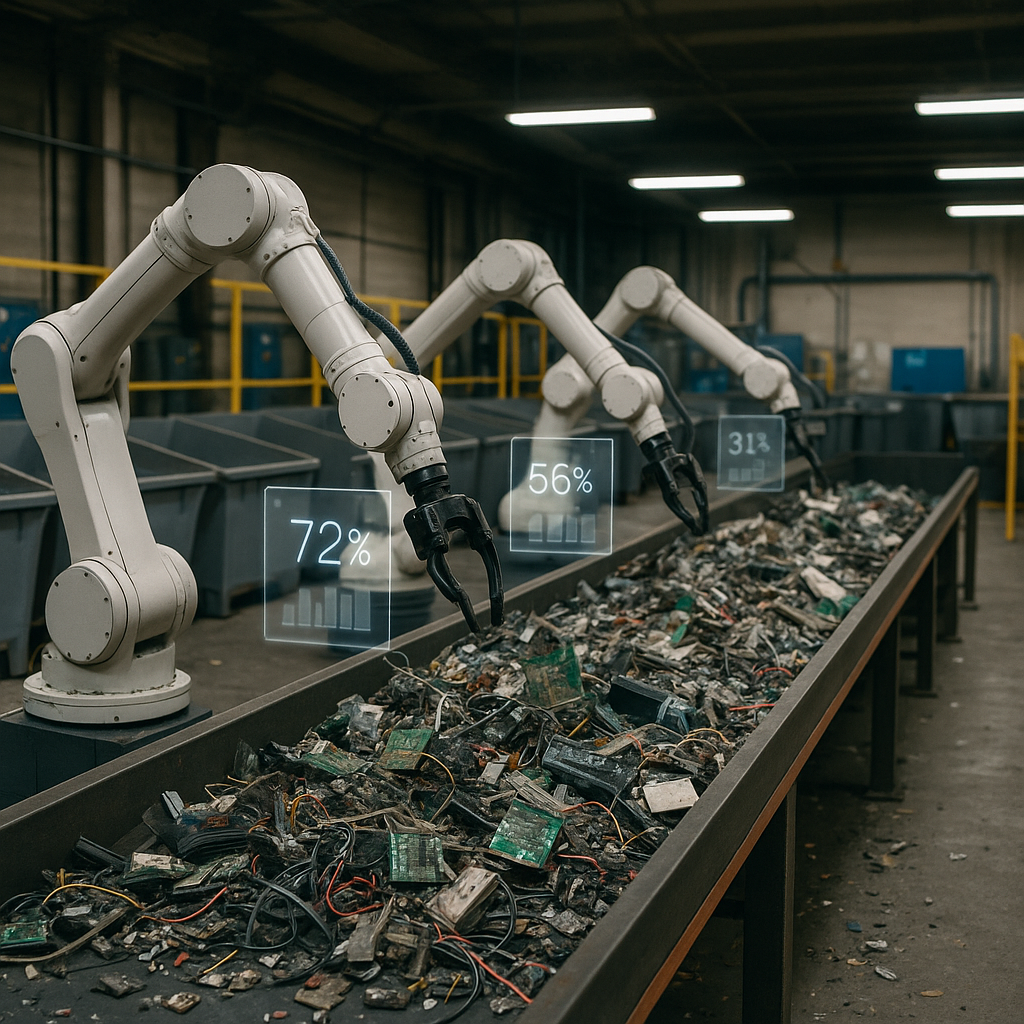5901 Botham Jean Blvd, Dallas, TX 75215
What Are the Key Challenges in Copper Recycling?
May 30, 2025Global demand for copper is increasing rapidly, with the International Energy Agency projecting a 50% rise by 2050. This essential metal supports our renewable energy transition, yet recycling it poses significant challenges. The recycling rate for end-of-life copper is currently just 32%, indicating considerable room for improvement.
Copper recycling faces several critical challenges that limit its effectiveness despite its environmental benefits. These issues range from collection difficulties to processing complexities. Addressing these challenges is crucial for developing more sustainable solutions.
The recycling industry must overcome these barriers to meet growing demand while reducing the environmental impact of copper production. Here, we examine the primary challenges that currently restrict copper recycling‘s full potential.
How Does the Complexity of Electronic Waste Impact Copper Recycling?

Electronic waste presents unique challenges for copper recycling that differ from traditional copper sources. While recycling a copper pipe might be straightforward, extracting copper from a smartphone requires navigating a complex array of tightly integrated components.
Modern electronics contain copper in multiple forms that require different extraction approaches. In circuit boards, copper is intertwined with fiberglass, resins, and other metals. A typical smartphone contains nearly 40% copper by weight, significantly more than what’s found in copper ore, but recovering it involves carefully separating it from dozens of other materials.
The miniaturization of electronics has made copper recovery increasingly difficult. As devices become smaller and more compact, manufacturers bond copper with various elements using specialized adhesives and soldering techniques. This integration creates technical barriers that make separation resource-intensive.
Material Diversity Complicates Extraction
The diverse nature of electronic components presents a major hurdle for recycling operations. A single circuit board can contain copper alongside hazardous substances like lead, mercury, and flame retardants. These materials require careful handling during processing, adding steps and costs to the recycling process.
The presence of precious metals like gold, silver, and palladium further complicates copper recovery. While these metals improve the economics of e-waste recycling, they often require prioritized extraction. In waste printed circuit boards, copper represents only about 20% of the value, while precious metals account for up to 95%.
Different electronic devices contain varying amounts of copper. Cellphones contain approximately 36% copper, while TV circuit boards contain about 10%. This variability means recycling facilities must adapt their processes based on the specific e-waste stream they’re handling.
Technical Challenges in Processing Methods
Copper recovery from e-waste typically employs pyrometallurgical or hydrometallurgical processes, each presenting unique challenges. Pyrometallurgical approaches involve smelting at high temperatures, which requires careful balancing of heat and materials. The metallurgical reactions reach equilibrium quickly, causing constant changes in the chemical composition of the e-waste.
These processes also generate by-products like slag, soot, and toxic gases that pose environmental risks. The formation of slag particularly affects yield by hindering metal recovery. Additionally, plastics in electronics can generate harmful emissions when burned during smelting, requiring expensive treatment systems.
Hydrometallurgical approaches use chemical reagents to extract copper but face challenges with mixed materials. Lixiviating agents like acids must be carefully selected to target copper without excessive consumption by other metals. The abundance of other elements in e-waste causes reagent consumption and interference during the recovery process.
Economic and Infrastructure Barriers
The economics of copper recycling from electronics can be challenging compared to virgin copper mining. Mining operations benefit from economies of scale that many recycling operations cannot match. While recycling uses up to 85% less energy than mining, it still represents a substantial cost.
Collection infrastructure presents another significant hurdle. Unlike regular waste streams, e-waste requires specialized handling networks. Many regions lack convenient drop-off locations, making it easier for consumers to discard electronics with regular trash. This problem is particularly evident in rural areas where transportation costs make collection economically prohibitive.
Market fluctuations also complicate the financial viability of copper recycling. When copper prices drop, the economic incentive for recycling diminishes. This volatility makes long-term investment in recycling infrastructure risky for businesses.
Despite these challenges, technological innovations are improving copper recovery rates. Advanced pyrometallurgical processes can now achieve copper recovery rates of 94-97%, substantially higher than earlier methods. Hydrogen-based reduction methods show promise for reducing the carbon footprint of copper recycling.
What Role Do Product Design and Regulations Play in Copper Recycling?

Current product engineering approaches pose significant obstacles for copper recycling. Many electronics manufacturers prioritize aesthetic appeal, cost reduction, and performance without considering end-of-life dismantling. This oversight results in complex assemblies where valuable copper components are tightly integrated with other materials, making separation labor-intensive and costly.
The lack of standardized design protocols across the electronics industry compounds these challenges. Recyclers must constantly adapt their processes to handle different product architectures, connection methods, and material compositions. For example, a typical smartphone contains copper in various forms—from wiring and circuit boards to connectors and micro-components—each requiring different extraction methods.
Using standardized components and connection methods across products would significantly simplify the recycling process. When fasteners, connectors, and assemblies follow consistent patterns, automated disassembly becomes more efficient. These design modifications could dramatically improve copper recovery rates while reducing processing costs.
Design for Recycling Principles
The most effective improvements begin at the product design stage. Electronics designed with disassembly in mind facilitate easier separation of valuable materials. This approach requires collaboration between manufacturers, designers, and recycling specialists to create products that maintain functionality while enabling efficient resource recovery.
Reducing the use of composite materials that are difficult to separate also improves recyclability. Clear material identification and minimizing the variety of materials used can significantly enhance copper recovery rates. These design changes would transform what is currently a waste management challenge into an economic opportunity.
The high electrical and thermal conductivity of copper can lead to more compact product designs, which reduce the consumption of other materials. For example, transformers with copper windings save electrical steel compared to units with aluminum windings, while induction motors with copper rotors result in smaller units for the same power output.
Regulatory Frameworks and Regional Variations
Regulatory approaches to e-waste management vary dramatically worldwide, creating inconsistent markets for recovered copper. Some regions have implemented Extended Producer Responsibility (EPR) programs that require manufacturers to manage their products throughout their lifecycle. These policies create economic incentives for designing products that are easier to recycle.
The European Union has demonstrated success through its End-of-Life Vehicles Directive, which mandates 95% recovery and 85% recycling of materials, including copper. Similar frameworks could be adapted specifically for electronic waste to improve copper recovery rates. Without such regulations, recyclers struggle to establish economically viable operations.
Cross-border regulations present additional challenges. China’s solid waste import ban in 2017 significantly disrupted the global copper scrap trade, particularly for low-grade sources. This policy shift forced many countries to develop domestic recycling capacity, but the transition has been uneven.
Policy Implementation Challenges
Even well-designed policies face implementation hurdles. Weak enforcement mechanisms, limited oversight capacity, and corruption can undermine regulatory effectiveness. In many developing nations, informal recycling sectors operate outside regulatory frameworks, using dangerous methods like burning cables to recover copper.
Standardized labeling requirements for metal content would enable recyclers to quickly identify copper-rich components. This simple regulatory measure could improve sorting efficiency and increase recovery rates. However, implementing such standards requires coordination across multiple industries and government agencies.
Resource constraints also limit regulatory effectiveness. Many regions lack the technical expertise, infrastructure, and funding needed to enforce e-waste regulations properly. This creates gaps where improper disposal and unsafe recycling practices flourish despite formal prohibitions.
According to the Global E-waste Monitor, only 17.4% of global e-waste was formally documented and recycled in an environmentally responsible manner in recent years, while e-waste production continues to outpace recycling efforts by nearly five times. This gap highlights the urgent need for stronger regulatory frameworks.
Balancing Economic and Environmental Interests
Effective policies must balance environmental protection with economic realities. Overly stringent regulations can drive recycling activities underground or create barriers to market entry for smaller recyclers. The most successful approaches provide incentives for compliance while maintaining flexibility for technological innovation.
Financial incentives can play a crucial role in promoting proper e-waste management. These may include tax benefits for manufacturers who design recyclable products, subsidies for recycling facilities implementing best practices, or deposit systems that encourage consumers to return electronic devices for proper recycling.
The economic case for improved copper recycling is compelling. Recycled copper requires up to 85% less energy than mining and extraction of virgin materials. This energy saving translates to reduced greenhouse gas emissions and lower production costs, making recycling increasingly competitive as energy prices rise.
Cooperation across the entire value chain is essential for improving copper recovery rates. Academic-industry partnerships drive innovation through research into more efficient extraction methods. These collaborations lead to practical applications of new technologies at commercial scales.
| Region | Regulatory Framework | Key Features | Challenges |
|---|---|---|---|
| European Union | WEEE Directive | Mandatory EPR, high targets, lifecycle scope | None noted |
| United States | State-level initiatives | Flexible, state-driven approach | Lacks national cohesion, no federal targets |
| China | WEEE-like regulations | Focus on recycling infrastructure | Lacks transparency, narrow scope |
| Japan | Circular economy framework | Robust recycling infrastructure | Consumer-funded system, voluntary targets |
| South Korea | Act on Resource Circulation | EPR for 50 product types, 65% target by 2025 | Lighter enforcement, lacks eco-design requirements |
| India | E-Waste Management Rules | EPR targets, resembles WEEE scope | Weak enforcement, lacks eco-design controls |
| Switzerland | Ordinance on WEEE | Free take-back, 75% recovery targets | None noted |
What Technological and Economic Challenges Face Copper Recycling?

Copper recycling faces significant technological challenges. Current recycling processes have not evolved quickly enough to manage the increasing complexity of modern electronic products. This gap has led to lower recovery rates, especially for copper in complex circuit boards and microelectronics.
The extraction process presents substantial technical hurdles. Copper in electronic waste is often tightly integrated with fiberglass, resins, and other metals. This complex composition requires specialized separation techniques that are energy-intensive and technologically demanding. For example, waste printed circuit boards contain about 20% copper, but extracting it requires breaking strong bonds with surrounding materials.
Energy Consumption Challenges
While recycling copper requires less energy than primary production, it still demands considerable energy inputs. Pyrometallurgical methods, the most common approach for processing lower-grade copper scrap, operate at temperatures between 1200-1300°C, contributing to substantial energy consumption.
The presence of plastics in electronic waste creates additional energy efficiency problems. When burned during smelting, these plastics generate harmful emissions that require costly treatment systems. Some facilities have invested millions in gas treatment technology to address this issue, adding to overall energy and operational costs.
Advanced pyrometallurgical processes can achieve copper recovery rates of 94-97%, notably higher than earlier methods that managed only 79-83%. However, these improved recovery rates come with increased energy requirements that can offset some environmental benefits of recycling.
Economic Viability Issues
The economics of copper recycling face several challenges. Virgin copper mining operations benefit from economies of scale that many recycling facilities cannot match, creating a competitive disadvantage for recyclers, particularly smaller operations.
Market fluctuations significantly impact recycling profitability. When copper prices drop, the economic incentive for recycling diminishes, making long-term investment in recycling infrastructure financially risky and limiting capacity expansion.
Processing costs increase with material complexity. Electronic waste requires multiple stages of separation and refinement, with each step adding cost and potentially reducing yield, squeezing already tight profit margins for recyclers.
Collection and Infrastructure Limitations
One of the most pressing challenges is inadequate collection infrastructure. Unlike regular waste streams, electronic waste requires specialized handling networks. Many regions lack convenient drop-off locations, making it easier for consumers to discard electronics with regular trash.
The infrastructure gap is particularly evident in rural areas. Transportation costs often make collection economically prohibitive in less populated regions. Even urban centers with better systems frequently suffer from inadequate capacity to handle increasing volumes of discarded devices.
Consumer behavior creates additional challenges. Many people store unused electronics indefinitely rather than recycling them. Studies show the average household contains several unused electronic devices, creating a significant “hibernating” stock of potentially recoverable copper that remains inaccessible to recyclers.
Regulatory and Policy Barriers
Cross-border regulations significantly impact copper recycling markets. Recent policy changes have disrupted global copper scrap trade flows. China’s 2017 solid waste import ban substantially affected how low-grade scrap sources are processed globally, forcing major adjustments in recycling supply chains.
In Europe, regulatory hurdles make it difficult to ship scrap between EU countries. High operational costs combine with these restrictions to create significant barriers for European recyclers. The trade-off between increasing recycling of lower-grade scrap and reducing carbon dioxide emissions to meet climate goals creates additional regulatory complexity.
In the United States, a major bottleneck is insufficient smelting and refinery capacity, particularly for processing end-of-life copper. This infrastructure limitation restricts domestic processing capabilities, though new facilities are gradually coming online or in development.
Conclusion: The Future of Copper Recycling

Copper recycling is a cornerstone of environmental sustainability and resource conservation in our resource-constrained world. Despite challenges from complex extraction processes and product design limitations, recycling this versatile metal provides significant environmental benefits. It uses up to 85% less energy than primary production and significantly reduces greenhouse gas emissions, making copper recycling one of our most effective sustainability practices.
As global copper demand rises, driven by growth in renewable energy systems and electric vehicles, efficient recycling systems will become increasingly important. The emergence of advanced technologies, including AI-powered sorting systems and specialized extraction methods, promises to overcome current recovery obstacles. Supported by regulatory frameworks and improved product design, these innovations pave the way for a more sustainable copper economy.
For organizations seeking expert guidance on copper recycling solutions, contact Okon Recycling at 214-717-4083.
